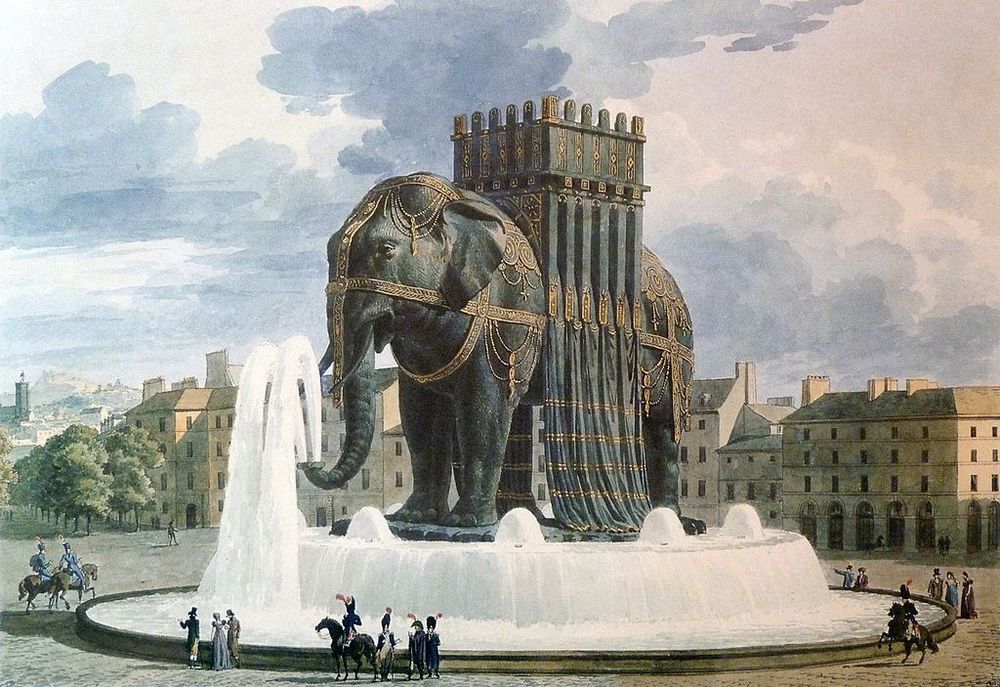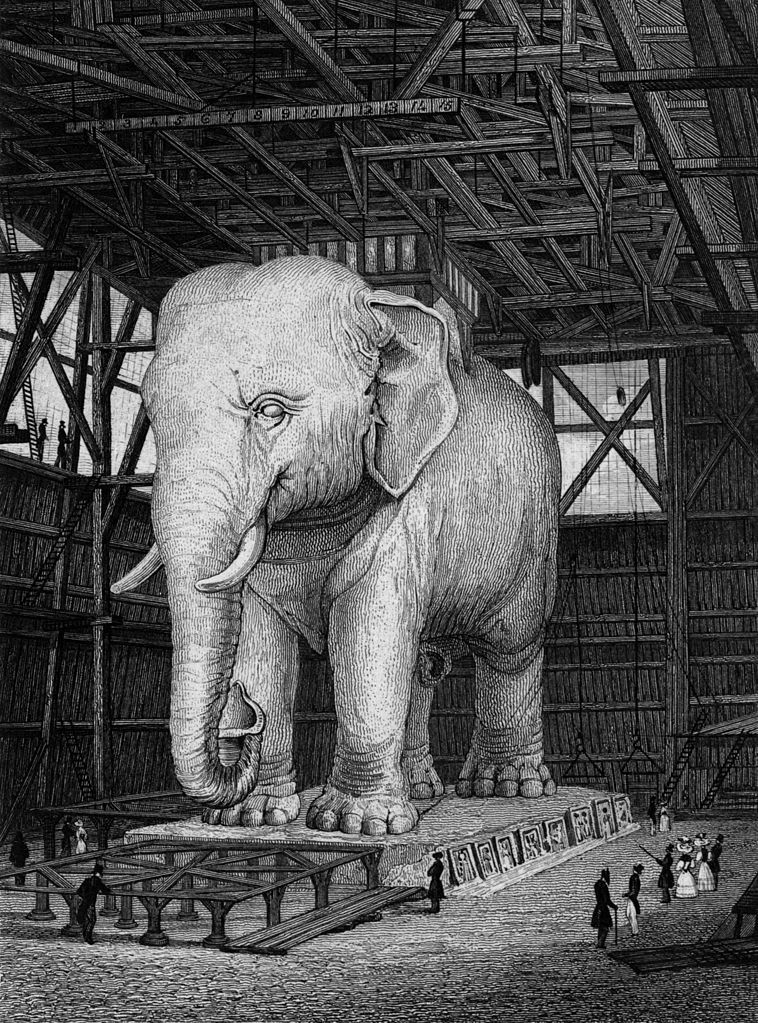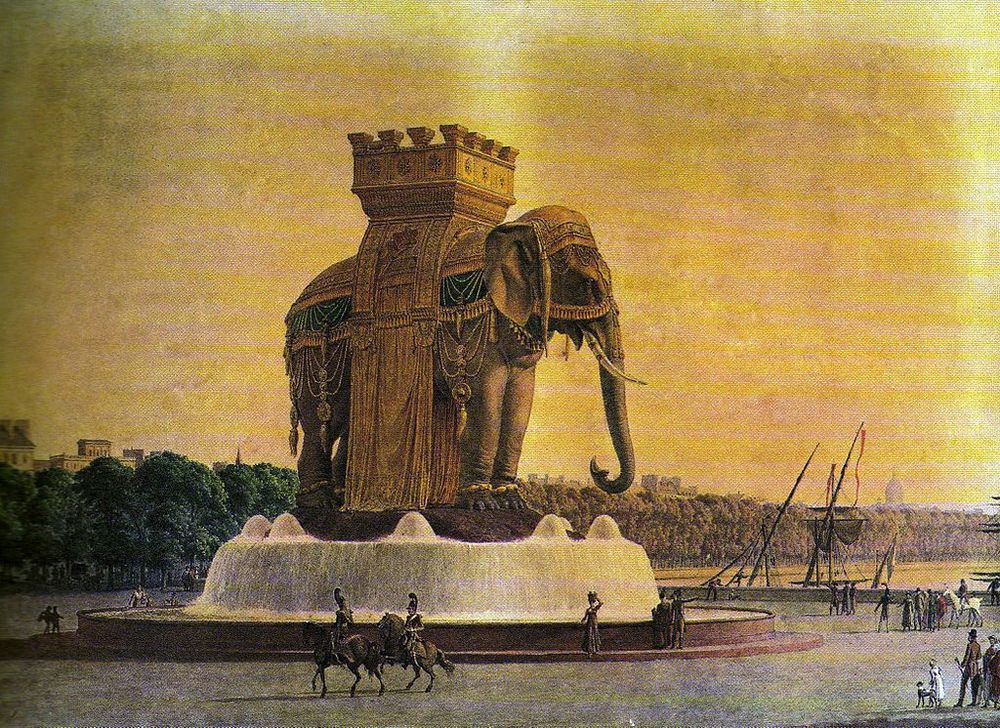Between 1814 and 1846, there stood a colossal plaster elephant in the heart of Paris, at the site of the former Bastille prison. For much of this time it presented a sorry spectacle. One tusk had fallen off, and the other was reduced to a powdery stump. Its body was black from rain and soot, and large cavities had opened in its torso where rodents, stray cats and vagrants took shelter. The plinth was overgrown by dandelions and thistles.
This was not the sight Napoléon Bonaparte had intended when he ordered the elephant built. It was supposed to be a monument to his victories, built out of bronze from melted canons he captured during his conquests. The elephant’s trunk would spout water, while one of its legs, measuring 6 feet across, would house a winding staircase leading to the howdah.

Elephant of the Bastille. Watercolour by architect Jean-Antoine Alavoine. Photo: Wikimedia Commons
When the Bastille fell in July 1789 and subsequently demolished, there was some debate as to what should replace the former prison. It was decided that the area would become a square celebrating liberty, and a column would be erected there. A foundation stone was laid but the column never materialized. Instead, a fountain was built in 1793, depicting the Egyptian God Isis with water flowing from her breasts. But Napoleon had more grandiose plans. In 1810, the emperor decreed that a new fountain was to be erected, in the shape of an elephant, one that would be heroic and delightful to all who beheld it.
Dominique Vivant, a French artist, writer, diplomat, archaeologist, and the first Director of the Louvre museum was given the task of overseeing the project. Jacques Cellerier was chosen as the architect and work began in 1810 on the ground works, with the vaults and underground pipes completed by 1812. At this point Cellerier was replaced by Jean-Antoine Alavoine, who realizing the need to show how the finished work would look, recruited sculptor Pierre-Charles Bridan to create a full-size model using plaster over a wooden frame. Standing as high as a three story house, the Elephant of the Bastille stood an imposing figure towering over a square that saw so many violent protests, angry demonstrations and royal humiliations.

The plaster model of the Elephant for the Place de la Bastille. Engraving by artist Augustus Charles Pugin. Photo: Wikimedia Commons
After Napoleon's defeat in Waterloo in 1815, the empire collapsed and construction stopped. Still, Alavoine continued to seek financial support to complete the project as late as the 1830s, even as the plaster elephant started to crumble.
The elephant appeared prominently in Victor Hugo’s novel Les Misérables (1862), where the street urchin Gavroche took shelter within the tottering pachyderm. Hugo painted a very accurate picture of the elephant’s miserable state:
Few strangers visited this edifice, no passer-by looked at it. It was falling into ruins; every season the plaster which detached itself from its sides formed hideous wounds upon it. “The aediles,” as the expression ran in elegant dialect, had forgotten it ever since 1814. There it stood in its corner, melancholy, sick, crumbling, surrounded by a rotten palisade, soiled continually by drunken coachmen; cracks meandered athwart its belly, a lath projected from its tail, tall grass flourished between its legs; and, as the level of the place had been rising all around it for a space of thirty years, by that slow and continuous movement which insensibly elevates the soil of large towns, it stood in a hollow, and it looked as though the ground were giving way beneath it. It was unclean, despised, repulsive, and superb, ugly in the eyes of the bourgeois, melancholy in the eyes of the thinker.
Not only the elephant had become hideous, but it had become a menace as well, because of the rats that flowed out of it every night and raided the homes of the local residents. The people complained and petitioned for the elephant to be demolished in the late 1820. It wasn’t until 1846 that the plaster elephant was finally removed. Shortly after, it was replaced by the July Column that was erected to commemorate the Revolution of 1830.

Elephant of the Bastille, by an unknown artist. Photo: Wikimedia Commons
References:
# Simon Schama, Citizens: A Chronicle of the French Revolution
# Geri Walton, Fountain of the Elephant or the Elephant of the Bastille, Geri Walton
# Wikipedia



Comments
Post a Comment